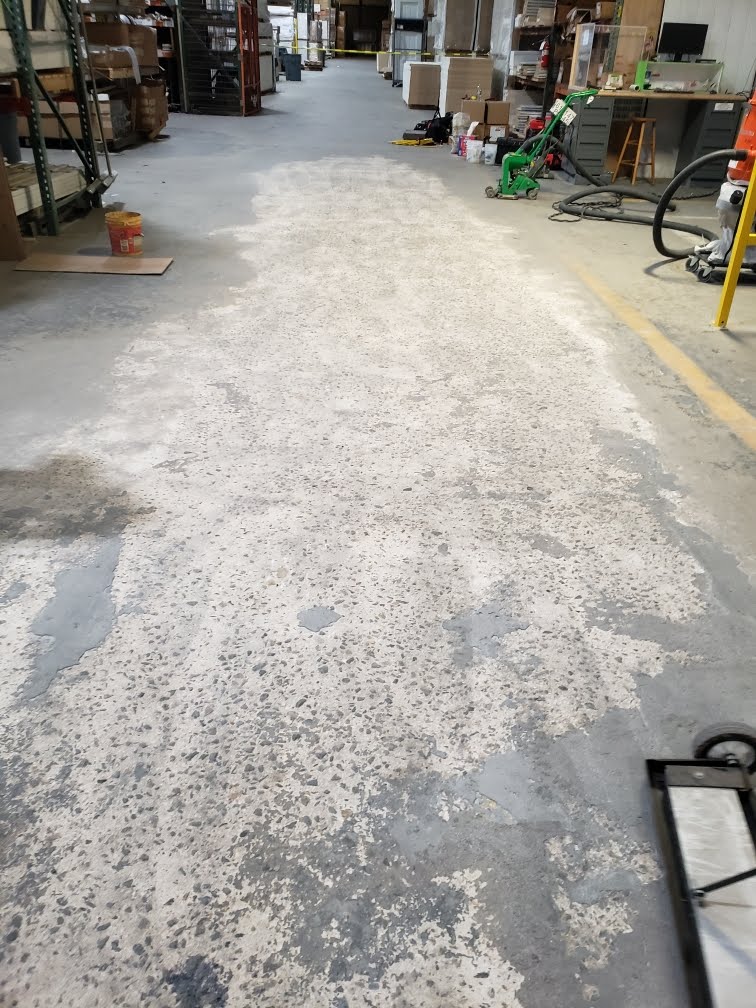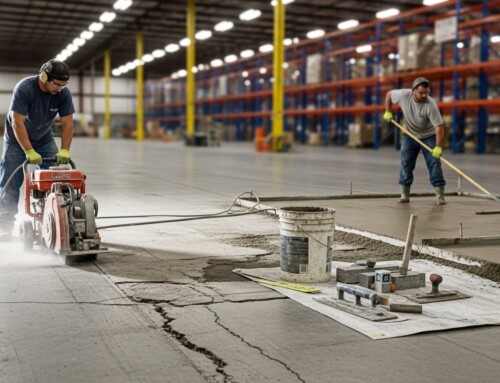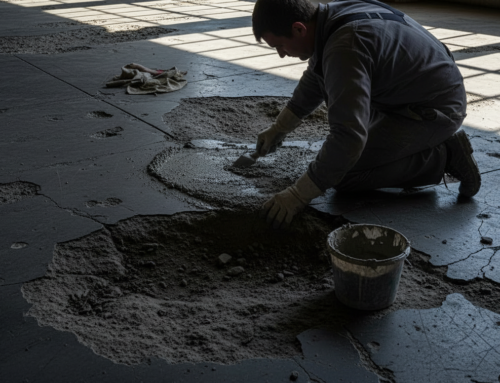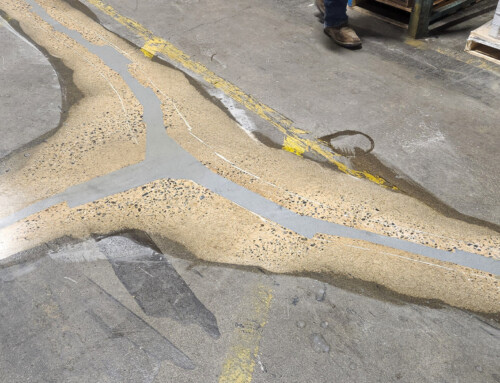IN THIS ARTICLE
Discover Warehouse Concrete Floor Spalling Causes, Fix, Prevention & Treatment
Warehouse floors endure a lot of wear and tear; one common issue is spalling. Spalling, or the occurrence of industrial concrete floor spalling, can be an alarming sign of floor deterioration. It is often instigated by extreme operating conditions, such as the frequent movement and weight of forklifts, which can lead to forklift damage.
But what exactly is spalling, and how can you fix it once it starts?
Understanding the repair process, including using specialized concrete repair products and repair techniques, is crucial for addressing problematic spalls. Additionally, it should be noted that some of the warehouse floor problems could stem from the carbonation process.
This chemical reaction occurs in concrete and may ultimately affect its durability by lowering the pH and reducing the protection against corrosion of the reinforcements. This post will cover the causes, like the forklift above damage, and lesser-known chemical evils like carbonation.
It will also cover effective fixes and prevention strategies, including sealing for carbonation protection—thereby slowing down the alkalinity reduction near the rebars—and real-world examples of successful spalling repairs.
By the end, you’ll understand how to keep your warehouse concrete floors resilient against such challenges and in top shape.
What Is Spalling in Warehouse Concrete Floors?
Spalling refers to the flaking, chipping, or breaking of concrete surfaces. It’s a significant concern in warehouse concrete floors because spalled areas can worsen over time if not addressed. Spalling typically begins as small cracks or chips on the surface, but if left untreated, it can lead to more severe structural issues.
You might notice spalling as rough patches on the surface where the concrete appears peeling away. This can be especially problematic in warehouses in high-traffic areas or where heavy equipment like forklifts operates. Not only does it affect the integrity of the floor, but it can also become a safety hazard for employees and equipment.
Common Causes of Spalling in Warehouse Concrete Floors
Understanding what causes spalling is the first step in addressing it effectively. Let’s explore some of the most common culprits:
Poor Concrete Mix or Installation
One of the leading causes of spalling is a poor concrete mix or improper installation. Utilizing the correct proportions of cement, aggregates, and water, as advised by current construction guidelines, is vital for reducing the risk of spalling.
Incorporating best practices during the substrate preparation, such as ensuring the aggregates are pre-wetted to SSD condition before applying cement mortar, can be critical to prevent such issues.
The structural integrity can be compromised if excessive water is introduced during the mixing or the substrate isn’t appropriately cleaned and textured with the recommended 6 mm amplitude. Similarly, improper placement and finishing and inadequate curing practices can significantly impair the concrete’s strength and expose it to surface deterioration over time, even with accurate joint placement to mitigate spalling risks.
Adhering to standards in placing, compacting, and especially curing, applying the right cementitious mortar for re-profiling works, and managing the expansive pressure from freeze-thaw cycles greatly improve the longevity and durability of concrete structures.
Freeze-Thaw Cycles
In regions with cold winters, freeze-thaw cycles can be a significant issue for concrete floors. Water that seeps into minute fissures within the concrete surface might lead to critical structural damage as it freezes and expands, exerting pressure sufficient to fracture the concrete.
This cycle is detrimental to concrete’s longevity, emphasizing the importance of proper concrete thickness in construction to withstand such stresses. Additionally, it’s crucial to curb the application of deicing salts on these vulnerable surfaces to mitigate corrosion and spalling.
Instead, consider safer alternatives or penetrating chloride blockers if deicing is necessary for safety during icy conditions. Over time, repeated freeze-thaw cycles can result in extensive spalling, particularly in unheated warehouses or areas directly exposed to harsh weather.
Water Penetration
Water is one of concrete’s biggest enemies. When water seeps into the concrete through cracks or porous surfaces, it weakens the structure from within, much like it soaks into the cement’s capillaries. If the water doesn’t drain properly and is subjected to freezing temperatures, it can cause long-term damage through expansion pressure within these capillaries.
This is particularly an issue in warehouses with leaks or poor drainage systems, where maintaining a properly prepared substrate is essential to prevent costly damage. In such cases, concrete resurfacing can be a viable solution to restore the floor’s integrity.
Corrosion of Reinforcing Steel (Rebar)
Concrete floors often contain reinforcing steel (rebar) for added strength. However, moisture penetrating the concrete and reaching the rebar can lead to surface rust, which may eventually cause the steel to rust and expand. This expansion puts pressure on the surrounding concrete, leading to spalling as the surface begins to break apart.
If left untreated, this corrosion process can cause more profound and extensive damage to the floor over time. To mitigate this, corrosion removal, such as wire brushing or abrasive blasting, is essential to maintaining the integrity of the reinforcement steel within the structure.
Heavy Load and High-Traffic Areas
Warehouses with heavy machinery, forklifts, and high traffic experience more floor wear and tear. Surface abrasion from the constant weight and movement can cause small cracks to form, eventually leading to spalling.
Proper joint placement is essential in these environments, as it helps manage the concrete’s stress points and reduce the likelihood of spalling. These issues can quickly escalate without proper maintenance and measures to create an abrasion-resistant surface, especially in areas where heavy loads are regularly transported.
How to Fix Spalling in Warehouse Concrete Floors
Once spalling begins, it’s important to take action quickly. Here’s how you can address the issue effectively:
Surface Patching and Repair
Surface patching is often the easiest and most cost-effective solution for minor spalling. The damaged area is cleaned thoroughly to remove loose concrete, and a bonding agent is applied to ensure the patch sticks to the existing surface. After carefully preparing the repair area, a specialized mortar repair compound is spread over it, filling in the spalled spots, repairing cracks, and smoothing the surface.
This method works well for smaller areas or early-stage spalling, preventing further damage while restoring the surface’s appearance. It is vital to select suitable repair materials designed for patch repairs and to ensure proper curing and protection of the repair areas.
Apply a Protective Concrete Coating
Applying a protective coating such as epoxy coatings or polyurea can help prevent future spalling. These high-performance coatings act as an impermeable barrier against moisture, chemicals, and heavy wear, offering enhanced durability and a waterproofing shield for your concrete floors.
Not only do they protect against spalling, but they also simplify cleaning and maintaining the floor, contributing to an extended lifespan and pristine appearance.
Replace Severely Damaged Areas
In cases of severe spalling, surface repairs might not be enough. If large sections of the floor are affected or the damage goes deeper into the concrete, the damaged portion may need to be removed and replaced.
This process of concrete slab placement should be meticulously planned to minimize downtime, especially in high-traffic areas. It involves cutting out the spalled section, preparing the subfloor, and pouring new concrete.
While this solution is more extensive, it’s necessary for floors with widespread spalling that compromise safety or functionality. Ensuring proper slab placement and finishing can help prevent the recurrence of such issues in the future.
Case Studies: Successful Spalling Repairs in Warehouses
To help you visualize how spalling can be addressed, here is a case study showcasing successful repairs in real-world warehouses:
Before-and-After Scenarios
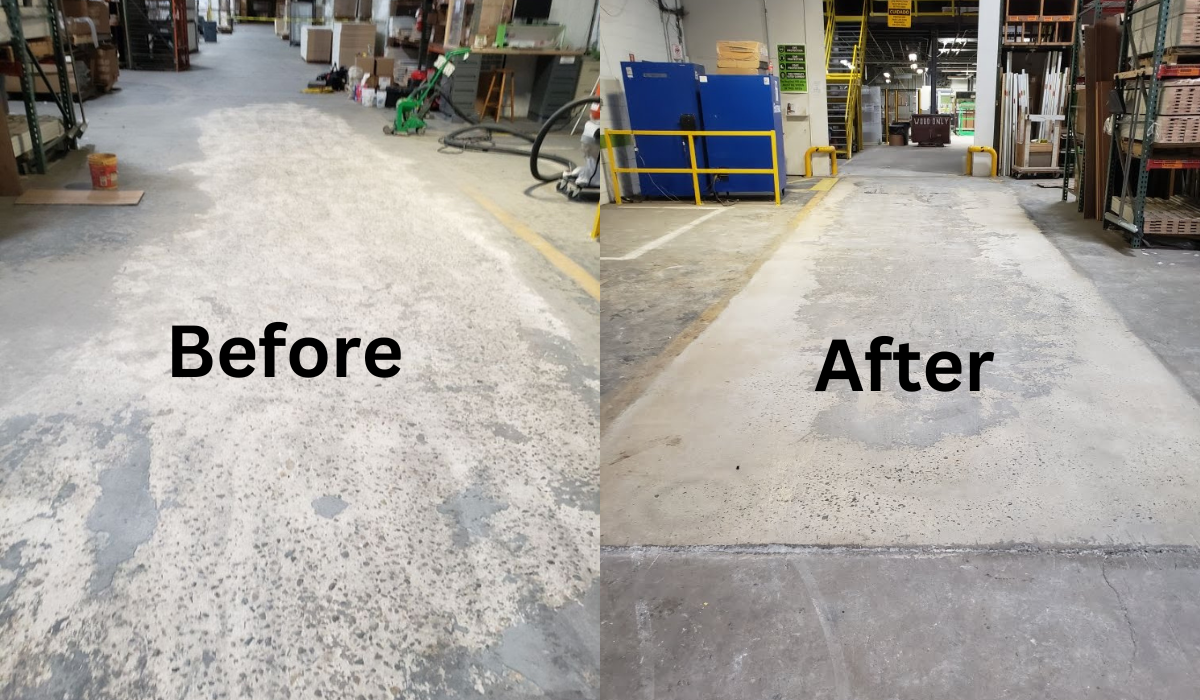
Preventing Spalling in Warehouse Concrete Floors
Prevention is always better than cure. Here are some practical ways to prevent spalling before it becomes a problem:
Regular Floor Maintenance
It is important to maintain your warehouse floors regularly. Regular cleaning, resealing, and addressing small cracks early can help prevent spalling from developing. A well-maintained floor is less likely to experience significant damage.
Ensure Proper Concrete Installation
When installing new concrete floors, it’s important to ensure they’re done right. Using the correct concrete mix and ensuring the floor is properly reinforced and cured will provide a strong foundation less prone to spalling.
Apply Sealants and Coatings
Applying a sealant or protective coating on your floors can provide a barrier against water, chemicals, and everyday wear and tear. This extra layer of protection is especially important in high-traffic or moisture-prone areas.
Control Temperature and Moisture
It is important to control indoor temperatures and manage moisture levels in warehouses in regions with freeze-thaw cycles. Installing proper drainage systems and maintaining a stable indoor temperature can prevent spalling caused by temperature fluctuations.
When to Call in Professional Repair Services
Sometimes, DIY fixes aren’t enough, and professional help is needed. If spalling covers a large area of your floor, or if the damage is deep and structural, it’s time to call in a professional concrete floor contractor.
Our team, comprised of seasoned contractors, specializes in repairing spalled concrete floors for warehouses. We provide long-lasting solutions that can save you time and money in the long run. We service cities across New Jersey and Pennsylvania, offering concrete leveling and repair options tailored to your warehouse’s needs.
Conclusion
Spalling in warehouse concrete floors can start small but lead to more significant issues if left unchecked. It’s essential to address spalling quickly and prevent future damage, whether caused by poor installation, freeze-thaw cycles, or heavy traffic. By following the prevention tips outlined here and knowing when to call in professional help, you can keep your warehouse floors in excellent condition for years.
Don’t hesitate to contact us if you need spalling or other concrete floor repairs. We proudly serve warehouses in New Jersey and Pennsylvania, providing expert repair and maintenance services to ensure your floors remain safe and durable.
FAQs on Spalling in Warehouse Concrete Floors
How Can I Tell if My Warehouse Floor Has Spalled?
Look for flaking, chipping, or rough patches on the concrete surface. Spalling can also appear as small cracks or breaks in the top layer of the floor.
Can Spalled Concrete Floors Be Fully Restored?
Yes, depending on the severity of the spalling. Minor cases can often be repaired with surface patching, while more severe cases may require replacing sections of the concrete.
How Often Should Warehouse Floors Be Inspected for Spalling?
Inspecting warehouse floors regularly, at least once every few months, is a good idea, especially in high-traffic areas. Early detection can prevent more costly repairs down the road.
Is spalling concrete a structural problem?
In early stages, spalling is usually a surface issue. However, if left untreated, it can compromise the structural integrity of the concrete, especially if it’s related to rebar corrosion.
- Will You Lose Your Deposit Over Warehouse Concrete Floor Cracks? - December 19, 2025
- Who Pays for Warehouse Concrete Floor Repairs in a Lease? - December 19, 2025
- Can You Fix Concrete Floor Gouges Yourself? - December 19, 2025
